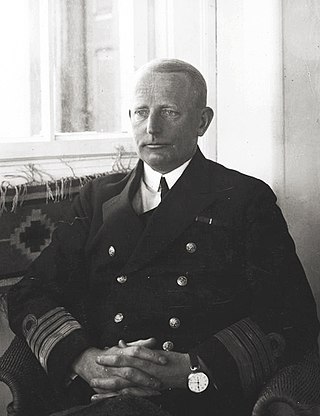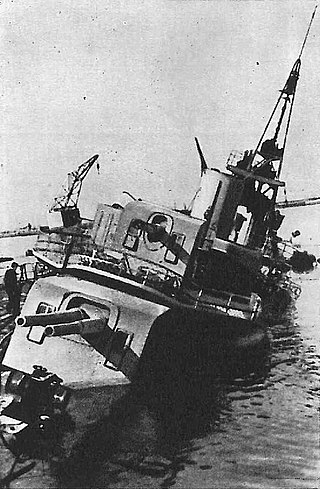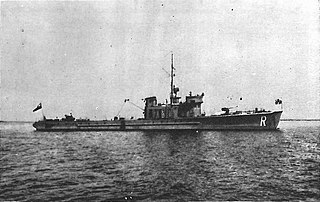
The Siege of Warsaw in 1939 was fought between the Polish Warsaw Army garrisoned and entrenched in Warsaw and the invading German Army.

The Battle of the Bzura was both the largest battle and Polish counter-attack of the German invasion of Poland and was fought from 9 to 19 September. The battle took place west of Warsaw, near the Bzura River. It began as a Polish counter-offensive, which gained initial success, but the Germans outflanked the Polish forces with a concentrated counter-attack. That weakened Polish forces and the Poznań and Pomorze Armies were destroyed. Western Poland was now under German occupation. The battle has been described as "the bloodiest and most bitter battle of the entire Polish campaign". Winston Churchill called the battle an "ever-glorious struggle".

Józef Unrug was a Polish admiral who helped establish Poland's navy after World War I. During the opening stages of World War II, he served as the Polish Navy's commander-in-chief. As a German POW, he refused all German offers to change sides and was incarcerated in several Oflags, including Colditz Castle. He stayed in exile after the war in the United Kingdom, Morocco and France where he died and was buried. In September 2018 he was posthumously promoted in the rank of vice admiral by the President of Poland. After 45 years his remains, along with those of his wife Zofia, were exhumed from Montrésor and taken in October 2018 to his final resting place in Gdynia, Poland.

The Battle of Danzig Bay took place on 1 September 1939, at the beginning of the invasion of Poland, when Polish Navy warships were attacked by German Luftwaffe aircraft in Gdańsk Bay. It was the first naval-air battle of World War II.
This article details the order of battle of the Polish Navy prior to the outbreak of World War II and the Polish Defensive War of 1939. Following World War I, Poland's shoreline was relatively short and included no major seaports. In the 1920s and 1930s, such ports were built in Gdynia and Hel, and the Polish Navy underwent a modernisation program under the leadership of Counter-Admiral Józef Unrug and Vice-Admiral Jerzy Świrski. Ships were acquired from France, the Netherlands, and the United Kingdom, and the navy was to be able to secure the Polish supply lines in case of a war against the Soviet Union. By September 1939 the Polish Navy consisted of 5 submarines, 4 destroyers, and various support vessels and mine-warfare ships.

Oksywie is a district of the city of Gdynia, Pomeranian Voivodeship, northern Poland. Formerly a separate settlement, it is older than Gdynia by several centuries.
Kraków Army was one of the Polish armies which took part in the Polish Defensive War of 1939. It was officially created on March 23, 1939 as the main pivot of Polish defence. It was commanded by Gen. Antoni Szylling. Originally, Kraków Army was to be made of seven infantry divisions, two cavalry brigades and one mountain brigade. On September 1, 1939, General Szylling had the force which consisted of five infantry divisions, two cavalry brigades and one brigade of mountain infantry. Altogether, the army was made of 59 battalions, 29 squadrons, 352 cannons, 90 tanks, two armoured trains and 44 planes. These forces were not enough to halt German advance, especially in the area north of Częstochowa, where Kraków Army connected with Łódź Army. Main thrust of Wehrmacht panzer units was directed there, and this area was defended only by the Polish 7th I.D., which was destroyed in the early days of September 1939, opening the way towards central Poland.

The Battle of Hel was a World War II engagement fought from 1 September to 2 October 1939 on the Hel Peninsula, of the Baltic Sea coast, between invading German forces and defending Polish units during the German invasion of Poland. The defense of the Hel Peninsula took place around the Hel Fortified Area, a system of Polish fortifications that had been constructed in the 1930s near the interwar border with the German Third Reich.

The Battle of Kępa Oksywska took place in the Oksywie Heights outside the Polish city of Gdynia between 10 and 19 September 1939. The battle, fought by the Polish Army and the German Wehrmacht, was part of the Polish September Campaign during World War II. It was one of the bloodiest battles of the campaign, with Polish KIA losses reaching roughly 14% of all the forces engaged.

The Worek Plan was an operation of the Polish Navy in the first days of World War II, in which its five submarines formed a screen in order to prevent German naval forces from carrying out landings on the Polish coast, and to attack enemy ships bombarding Polish coastal fortifications, in particular the base on the Hel Peninsula.
Land Coastal Defence, commanded by Colonel Stanisław Dąbek, was an important unit tasked with the defence of Poland's Baltic Sea coast during the 1939 invasion.
The Warsaw Army was one of the Polish armies to take part in the Polish Defensive War of 1939. Created on 8 September, eight days after the invasion begun, it was an improvised formation charged with the defence of the Polish capital of Warsaw (Warszawa).

Army Poznań, led by Major General Tadeusz Kutrzeba, was one of the Polish Armies during the Invasion of Poland in 1939.

Plan West was a military plan of the Polish Army of the Second Polish Republic, for defence against invasion from Nazi Germany. It was designed in the late 1930s.
Czersk Operational Group was an Operational Group of the Polish Army. Formed in 1939 under the name of Tuchola Detachment as part of the Intervention Corps created in order to counter a possible German action in the Free City of Danzig, it was not disbanded after the end of the Danzig Crisis. Instead it was pressed into the newly formed Pomorze Army of Gen. Władysław Bortnowski and took part in the fights against the German and Soviet Invasion of Poland later that year.

ORP Rybitwa was a Jaskółka-class minesweeper of the Polish Navy at the outset of World War II. Rybitwa participated in the defence of Poland during the Nazi German invasion of 1939. The ship was damaged by a German bomb on 14 September 1939. The ship was later captured by the Germans, but returned to serve under the Polish flag after the War.

The Polish Navy is the naval branch of the Polish Armed Forces. The Polish Navy consists of 46 ships and about 12,000 commissioned and enlisted personnel. The traditional ship prefix in the Polish Navy is ORP.
Armored trains of Poland mostly date to the World War I period. Many of them were modernized over the next two decades, and took part in most military conflicts of the Second Polish Republic, namely the Greater Poland Uprising, the Polish-Ukrainian War, the Polish-Bolshevik War, the Silesian Uprisings and the Polish September Campaign in World War II. Armored trains were also used by the Polish Armed Forces in the West as well as in the post-war period by the Polish Railroad Guards and the People's Army of Poland.
Kutno Operational Group, named after the town and major rail junction of Kutno,, was an Operational Group of the Polish Army, created in March 1939, a few months before the Invasion of Poland. Its official name was Kutno Reserve Group of Commander-in-Chief, and it remained under direct control of Commander-in-chief of the Polish Army, Marshal Edward Smigly-Rydz.

Stanisław Dąbek was a Polish infantry colonel in the Polish Armed Forces, he was commander of the Marine Brigade of National Defense and acting commander of the Land Defense of the Coast during the Invasion of Poland; posthumously promoted to the rank of brigadier general.













